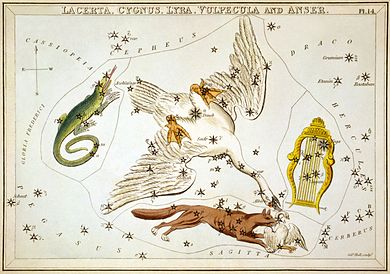Learn about the double stars of the constellation Lyra and how Orpheus used his lyre to charm women and Hades the god of the underworld. He even saved Jason and the Argonauts from the lure of the Sirens.
Symbolism: Lyra the lyre, a musical instrument with strings used in antiquity.
 Mythology: Lyra represents the lyre of Orpheus, the musician and poet in Greek mythology. There are many stories of Orpheus. In one he saves Jason and the Argonauts when his beautiful music quells the voices of the Sirens as they attempted to lure the Argonauts to their death on the rocky shores of the Sirens’ Island. In another story Orpheus descends into the underworld to bring his wife back to life. Orpheus charms Hades with his melodies, but ultimately fails to bring Eurydice back to the land of the living.
Mythology: Lyra represents the lyre of Orpheus, the musician and poet in Greek mythology. There are many stories of Orpheus. In one he saves Jason and the Argonauts when his beautiful music quells the voices of the Sirens as they attempted to lure the Argonauts to their death on the rocky shores of the Sirens’ Island. In another story Orpheus descends into the underworld to bring his wife back to life. Orpheus charms Hades with his melodies, but ultimately fails to bring Eurydice back to the land of the living.
When is it visible? The constellation Lyra is best seen from June through October in the northern hemisphere and much of the southern hemisphere directly overhead. Follow the Name a Star Space Blog to learn what is coming in September?
How to find it? Lyra, the northernmost of the August constellations, is relatively small, and easy to find because its brightest star, Vega (Alpha Lyrae), is the the second brightest star in the northern sky, slightly dimmer only than Arcturus.
History and Science: First catalogued by the astronomer Ptolemy in the 2nd century. Lyra is home to two variable eclipsing stars, Beta Lyrae and RR Lyrae, which are so close together that they exchange mass. These binary stars sometimes appear as one star as they rotate around each other. Beta and RR already have names, but many other binary stars exist that make perfect anniversary or romantic gifts at Name a Star.
The area corresponding to Lyra was seen by the Arabs as a vulture or an eagle diving with folded wings. In Wales, Lyra is known as King Arthur’s Harp (Talyn Arthur), and King David’s harp. The Persian Hafiz called it the Lyre of Zurah. It has been called the Manger of the Infant Saviour, Praesepe Salvatoris. In Australian Aboriginal astronomy, Lyra is known by the Boorong people in Victoria as the Malleefowl constellation. Lyra was known as Urcuchillay by the Incas and was worshipped as an animal deity.
